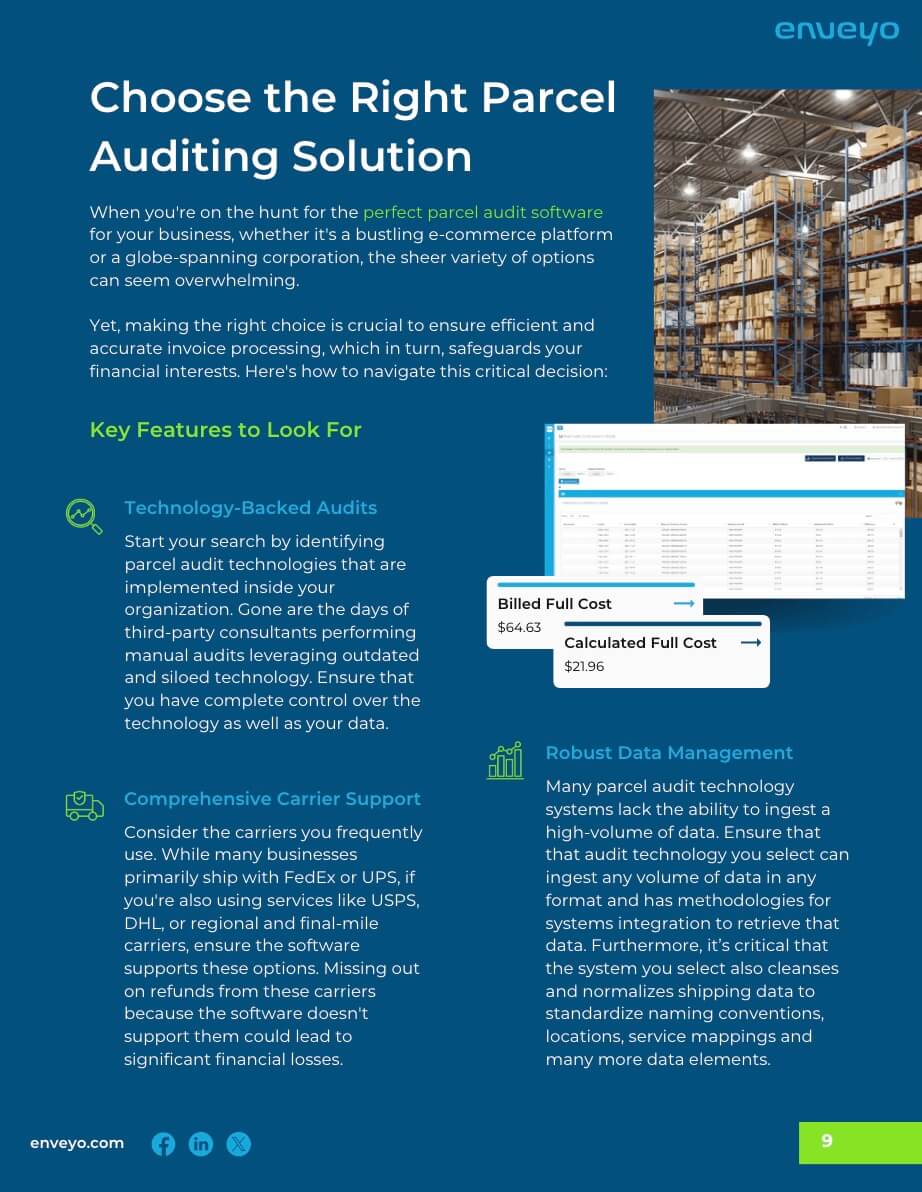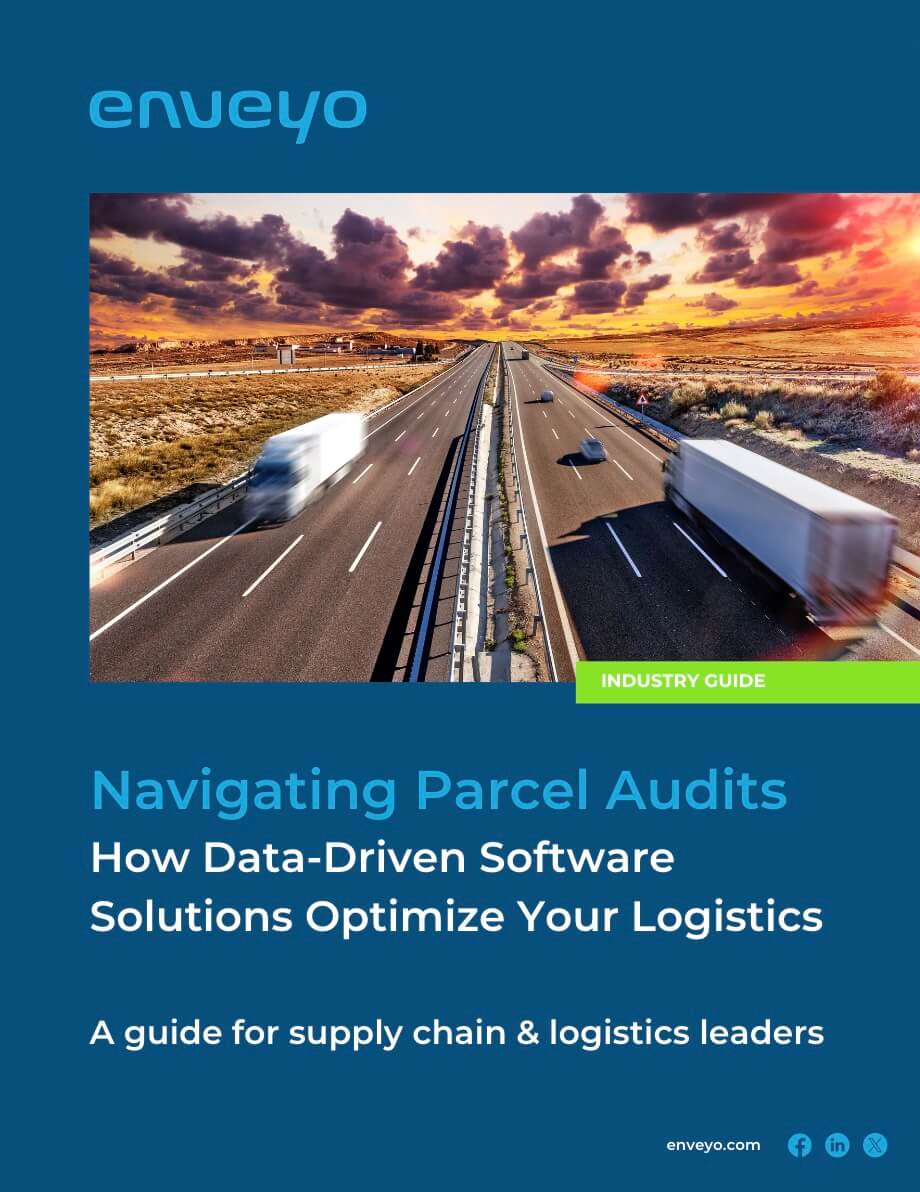Are you tired of losing money on shipping costs? Small parcel auditing might be the game-changer your e-commerce business needs. As online shopping continues to boom, the impact of shipping expenses on your bottom line has never been more significant. By mastering the art of small parcel audits, you can uncover hidden savings and boost your profitability in ways you might not have imagined.
Small Parcel Auditing Strategies for E-commerce
In this article, we’ll dive into the world of small parcel auditing and show you how to make it work for your business. You’ll learn about the connection between shipping costs and e-commerce success, how to set up an effective audit system, and advanced techniques to squeeze every penny out of your parcel shipments. Whether your shipping volume is small or large, these strategies will help you optimize your shipping processes and stay ahead in the competitive e-commerce landscape.
The Impact of Shipping Costs on E-commerce Profitability
Understanding Shipping Expenses
As an e-commerce business owner, you know that shipping costs can significantly impact your profitability. These expenses affect your bottom line in several ways. First, high shipping costs can reduce your profit margins, making it challenging to compete on price. Second, customers may abandon their carts when faced with high shipping fees, leading to lost sales. Third, excessive shipping costs can result in negative reviews and customer dissatisfaction, harming your reputation and future sales.
To illustrate the impact, let’s consider an example. Suppose you sell a product for $50, and the shipping cost is $10. If you offer free shipping, you’ll have to absorb the $10 cost, reducing your profit margin. However, if you charge $10 for shipping, customers may be deterred by the high cost and abandon their carts.
A study by the Baymard Institute revealed that 60% of respondents abandoned their carts due to high extra costs like shipping, taxes, and fees. This highlights the significant impact shipping costs can have on your conversion rate and revenue.
How Shipping Errors Affect Your Bottom Line
Shipping errors can also have a detrimental effect on your e-commerce business. Mis-shipments, where goods are sent to the wrong recipient or incorrect items are shipped, can lead to costly delays and dissatisfied customers. When products are sent late or not at all, businesses often have to offer refunds or discounts to appease customers, resulting in financial losses.
Moreover, shipping errors can alienate customers, decreasing sales and damaging your business’ reputation. Delays caused by mis-shipments can also disrupt the entire shipping process, creating backlogs and increasing costs as you try to manage these issues.
The Role of Auditing in Cost Control
To mitigate the impact of shipping costs and errors, implementing robust parcel audit software is crucial. By auditing your shipping processes and carrier performance, you can identify areas for optimization and cost savings.
- Identify Overcharges and Errors: A thorough parcel audit can help you identify overcharges, incorrect rates, and billing errors, ensuring you only pay for the services you receive.
- Analyze Shipping Data: Auditing provides valuable insights into your shipping data, including shipment trends and patterns. By analyzing this data, you can identify opportunities to reduce costs, such as consolidating shipments or negotiating better rates with carriers.
- Streamline Processes: Auditing can help you identify inefficiencies in your shipping processes, allowing you to streamline operations and reduce the risk of errors.
By implementing a comprehensive system for automated parcel audits, you can gain control over your shipping costs, minimize errors, and ultimately improve your e-commerce profitability.
Setting Up a Small Parcel Audit System
Choosing Between In-house and Outsourced Auditing
As you embark on setting up your small parcel audit system, you’ll need to decide whether to handle the parcel and freight auditing process in-house or outsource it to a third-party audit service.
- In-house Auditing: By managing the audit process and technology internally, you gain direct control and visibility over every aspect of the operation. This approach allows you to customize the freight auditing process to your specific needs and concentrate on areas that historically show higher rates of discrepancies. Leveraging automated parcel audit technology in-house also provides logistics teams with an invaluable source of real-time visibility into comprehensive shipping data that fuels strategic initiatives.
- Outsourced Auditing: Partnering with a third-party small parcel audit service provider used to be common practice, especially for businesses with high shipping volumes. However, modern shippers and 3PLs are moving away from third-party audit consultancies, as the need for real-time visibility into parcel shipping data is critical to making quick, strategic shifts in your parcel program. Making changes to audit reports, business rules, or even getting access to your parcel shipping data can take days, or even weeks, which is time that modern organizations just don’t have when it comes to the pace of e-commerce shipping.
“We have a lot of experienced people on our team, so the ability to self-manage things like adding new customers, managing rates, and changing business rules was important to us. Many traditional freight audit companies require that they manage this on their side, so the Enveyo model was very intriguing to us.”
Jeff McDermottEVP of Transportation in Americas, GEODIS
Essential Features of Auditing Software
Regardless of whether you choose an in-house or outsourced approach, the parcel audit software you select should possess certain essential features to ensure a comprehensive and efficient auditing process.
- Data Integration: The software should seamlessly integrate with your existing systems, such as your e-commerce platform, warehouse management system, and carrier interfaces. This integration ensures that shipping data is automatically ingested and processed, eliminating the need for manual data entry or manipulation.
- Automated Auditing: The software should be capable of automatically auditing invoices against contracted carrier rates, identifying discrepancies, and flagging potential issues. This automation reduces the risk of human error and streamlines the auditing process.
- Real-time Tracking: Robust auditing software should provide real-time tracking of shipments, enabling you to monitor the delivery status and identify any service failures or delays. This feature is crucial for promptly filing claims and securing refunds for late deliveries.
- Customizable Reporting: The software should offer customizable reporting and dashboards, allowing you to visualize your shipping data and gain valuable insights. These insights can help you identify areas for optimization, negotiate better rates with carriers, and make informed decisions about your shipping strategies.
Integrating Auditing with Your Existing Systems
To fully leverage the benefits of small parcel auditing, it’s essential to integrate the auditing software with your existing systems and processes. This integration ensures a seamless flow of data and minimizes manual intervention, reducing the risk of errors and inefficiencies.
- E-commerce Platform Integration: Integrate your auditing software with your e-commerce platform to automatically capture order data, including shipping details, customer information, and product details. This integration streamlines the auditing process and provides a comprehensive view of your shipping operations.
- Warehouse Management System (WMS) Integration: Connect your auditing software with your WMS to synchronize data related to inventory management, order fulfillment, and shipping processes. This integration enables you to track shipments from the point of origin and identify any discrepancies or inefficiencies in your fulfillment operations.
- Carrier Integration: Establish direct connections between your auditing software and the systems of your parcel carriers. This integration ensures that you have access to real-time tracking information, service updates, and invoicing data, enabling accurate and timely auditing.
- Accounting and Finance Systems Integration: Integrate your auditing software with your accounting and finance systems to streamline the invoicing and payment processes. This integration ensures that any recovered overcharges or refunds are automatically reflected in your financial records, providing accurate reporting and forecasting.
By setting up a comprehensive parcel audit system and integrating it with your existing systems, you’ll be well-equipped to gain complete visibility into your shipping operations, identify cost-saving opportunities, and optimize your e-commerce business for long-term profitability.
Navigating Parcel Audits Industry Guide
How Data-Driven Software Solutions Optimize Your Logistics


Advanced Auditing Techniques
Predictive Modeling for Future Savings
Advanced shipping analytics can leverage predictive modeling and simulation to forecast shipping volumes, anticipate demand fluctuations, and optimize shipping capacity accordingly. By using predictive analytics, you can make effective decisions about resource allocation, carrier selection, and overall shipping plans.
To implement predictive modeling, follow these steps:
- Collect historical data on your shipping operations.
- Identify the factors influencing demand for your products.
- Choose forecasting methods, such as time series analysis, regression analysis, market research, and expert opinions.
- Analyze the forecasted data and take necessary actions to optimize your shipping strategies.
Predictive logistics models can help you forecast freight quantities, identify potential delays, and improve routing, ultimately leading to cost savings and enhanced operational efficiency.
Data Analytics in Parcel Auditing
As an e-commerce business, you deal with massive amounts of shipping data, including order volumes, delivery times, shipping costs, carrier performance, and customer feedback. Advanced analytics techniques allow you to harness the power of this data, uncovering valuable insights to optimize your small parcel operations.
By leveraging shipping analytics, you can examine huge datasets, identify bottlenecks, and pinpoint opportunities for improvement. For instance, you can compare carrier performance based on delivery times, pricing structures, and service quality. This knowledge empowers you to negotiate better rates or switch to more cost-effective solutions. Additionally, shipping analytics can reveal the most efficient routes for delivering orders, reducing fuel costs and minimizing the number of required shipments.
- Centralize your shipping data using parcel audit software for a comprehensive view of carrier performance and costs.
- Integrate data from various sources, including historical shipments, market trends, and sensor data, for comprehensive analysis.
- Analyze historical data to identify demand fluctuations, plan strategies, make informed decisions, and optimize operations.
- Utilize data visualization tools to analyze shipping patterns effectively and uncover actionable logistics insights leading to cost savings and enhanced efficiency.
Continuous Improvement Strategies
Implementing advanced auditing techniques is not a one-time effort; it’s an ongoing process of continuous improvement. Regular parcel audits and data analysis can reveal trends and cost-saving opportunities, allowing you to make informed decisions about your shipping process.
- Conduct regular parcel audits to streamline the auditing process, minimize human errors, and ensure greater accuracy in detecting discrepancies.
- Analyze audit data to forecast future parcel spend, identify trends in spending, and avoid unnecessary expenses like duplicate charges or undelivered packages.
- Leverage automated parcel audit software to review shipping contracts, ensuring you receive the services you’re expecting and paying for.
- Continuously monitor key performance indicators (KPIs) like cost savings, carrier performance, and service quality to assess the effectiveness of your strategies.
By adopting a continuous improvement mindset and leveraging advanced auditing techniques, you can stay ahead of the curve, optimize your small parcel operations, and maximize profitability for your e-commerce business.
Let Data Drive Your Parcel Audits
Small parcel auditing is a game-changer for e-commerce businesses looking to boost their bottom line. By understanding the impact of shipping costs, setting up an effective audit system, and employing advanced techniques, shippers and 3PLs can uncover hidden savings and streamline their shipping processes. These strategies not only help to cut costs but also enhance customer satisfaction by ensuring timely and accurate deliveries.
To stay competitive in the ever-changing e-commerce landscape, businesses must continually optimize their small parcel auditing practices. By leveraging data analytics, predictive modeling, and continuous improvement strategies, companies can optimize their shipping operations and make informed decisions. Remember, mastering small parcel auditing isn’t just about saving money – it’s about creating a more efficient, customer-focused shipping experience that drives long-term success in the e-commerce marketplace.
Master Small Parcel Auditing with Enveyo

Eliminate exceptions, drive savings, and gain complete visibility into landed costs with freight and parcel audit software.
Chat with the Enveyo teamChat with the Enveyo team




